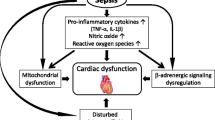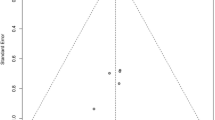Abstract
Background and Objective
As a β-adrenoceptor antagonist (β-blocker), esmolol can reduce cardiac output and the phosphodiesterase III inhibitor milrinone has been shown to improve heart contractility in patients with septic shock. This study was performed to assess the effects of esmolol combined with milrinone in patients with severe sepsis.
Methods
This prospective randomized study was conducted in patients with severe sepsis in the intensive care unit of the Jiangxi Provincial People’s Hospital (Nanchang, Jiangsu, China) between June 2013 and June 2014. Patients were randomly divided into control (C), milrinone (M), and milrinone–esmolol (ME) groups. The primary outcome was the rate of controlling the heart rate (HR) to achieve target levels. Secondary outcomes included the 28-day survival rate and changes in hemodynamic variables, organ function variables, myocardial injury markers, and the serum levels of proinflammatory factors.
Result
A total of 90 patients with severe sepsis were included in this study (30 per group). The HR in the ME group was lower than in the M and C groups after 12 h. The rate of successful HR control during the first 96 h was significantly higher in the ME group (60.0 vs. 33.3 % in the M group, vs. 26.7 % in the C group). Also, patients in the ME group had higher 28-day overall survival compared with the M (Log rank statistic = 5.452; P = 0.020) and C groups (Log rank statistic = 10.206; P = 0.001). Additionally, several variables showed significant improvement in the ME group 96 h after treatment compared with the M and C groups (P < 0.05).
Conclusion
Combination therapy with milrinone and esmolol could improve cardiac function and the 28-day survival rate in patients with severe sepsis.




Similar content being viewed by others
References
Angus DC, Linde-Zwirble WT, Lidicker J, Clermont G, Carcillo J, Pinsky MR. Epidemiology of severe sepsis in the United States: analysis of incidence, outcome, and associated costs of care. Crit Care Med. 2001;29:1303–10.
Dellinger RP. Cardiovascular management of septic shock. Crit Care Med. 2003;31:946–55.
Martin GS, Mannino DM, Eaton S, Moss M. The epidemiology of sepsis in the United States from 1979 through 2000. N Engl J Med. 2003;348:1546–54.
Linde-Zwirble WT, Angus DC. Severe sepsis epidemiology: sampling, selection, and society. Crit Care. 2004;8:222–6.
Dombrovskiy VY, Martin AA, Sunderram J, Paz HL. Rapid increase in hospitalization and mortality rates for severe sepsis in the United States: a trend analysis from 1993 to 2003. Crit Care Med. 2007;35:1244–50.
Phillips DP, Kaynar AM. Septic cardiomyopathy. Int Anesthesiol Clin. 2012;50:187–201.
Kumar A, Krieger A, Symeoneides S, Kumar A, Parrillo JE. Myocardial dysfunction in septic shock: part II. Role of cytokines and nitric oxide. J Cardiothorac Vasc Anesth. 2001;15:485–511.
Vieillard-Baron A. Septic cardiomyopathy. Ann Intensiv Care. 2011;1:6.
Hunter JD, Doddi M. Sepsis and the heart. Br J Anaesth. 2010;104:3–11.
Jozwiak M, Persichini R, Monnet X, Teboul JL. Management of myocardial dysfunction in severe sepsis. Semin Respir Crit Care Med. 2011;32:206–14.
Flynn A, Chokkalingam Mani B, Mather PJ. Sepsis-induced cardiomyopathy: a review of pathophysiologic mechanisms. Heart Fail Rev. 2010;15:605–11.
Kume T, Kawamoto T, Okura H, Toyota E, Neishi Y, Watanabe N, et al. Local release of catecholamines from the hearts of patients with tako-tsubo-like left ventricular dysfunction. Circ J. 2008;72:106–8.
Wittstein IS, Thiemann DR, Lima JA, Baughman KL, Schulman SP, Gerstenblith G, et al. Neurohumoral features of myocardial stunning due to sudden emotional stress. N Engl J Med. 2005;352:539–48.
Magder SA. The ups and downs of heart rate. Crit Care Med. 2012;40:239–45.
Gore DC, Wolfe RR. Hemodynamic and metabolic effects of selective beta 1 adrenergic blockade during sepsis. Surgery. 2006;139:686–94.
Lindsay CA, Barton P, Lawless S, Kitchen L, Zorka A, Garcia J, et al. Pharmacokinetics and pharmacodynamics of milrinone lactate in pediatric patients with septic shock. J Pediatr. 1998;132:329–34.
Dellinger R, Levy M, Rhodes A, Annane D, Gerlach H, Opal S, et al. Surviving Sepsis Campaign Guidelines Committee including the Pediatric Subgroup Surviving sepsis campaign: international guidelines for management of severe sepsis and septic shock: 2012. Crit Care Med. 2013;41:580–637.
Charpentier J, Luyt CE, Fulla Y, Vinsonneau C, Cariou A, Grabar S, et al. Brain natriuretic peptide: a marker of myocardial dysfunction and prognosis during severe sepsis. Crit Care Med. 2004;32:660–5.
Macchia A, Romero M, Comignani PD, Mariani J, D’ettorre A, Prini N, et al. Previous prescription of beta-blockers is associated with reduced mortality among patients hospitalized in intensive care units for sepsis. Crit Care Med. 2012;40:2768–72.
Suzuki T, Morisaki H, Serita R, Yamamoto M, Kotake Y, Ishizaka A, et al. Infusion of the beta-adrenergic blocker esmolol attenuates myocardial dysfunction in septic rats. Crit Care Med. 2005;33:2294–301.
Schmittinger CA, Dunser MW, Haller M, Ulmer H, Luckner G, Torgersen C, et al. Combined milrinone and enteral metoprolol therapy in patients with septic myocardial depression. Crit Care. 2008;12:R99.
Morelli A, Ertmer C, Westphal M, Rehberg S, Kampmeier T, Ligges S, et al. Effect of heart rate control with esmolol on hemodynamic and clinical outcomes in patients with septic shock: a randomized clinical trial. JAMA. 2013;310:1683–91.
Slack JA, Mcguirk SM, Erb HN, Lien L, Coombs D, Semrad SD, et al. Biochemical markers of cardiac injury in normal, surviving septic, or nonsurviving septic neonatal foals. J Vet Intern Med. 2005;19:577–80.
Post F, Weilemann LS, Messow CM, Sinning C, Munzel T. B-type natriuretic peptide as a marker for sepsis-induced myocardial depression in intensive care patients. Crit Care Med. 2008;36:3030–7.
Klouche K, Pommet S, Amigues L, Bargnoux AS, Dupuy AM, Machado S, et al. Plasma brain natriuretic peptide and troponin levels in severe sepsis and septic shock: relationships with systolic myocardial dysfunction and intensive care unit mortality. J Intensiv Care Med. 2013;29:229–37.
Mehta NJ, Khan IA, Gupta V, Jani K, Gowda RM, Smith PR. Cardiac troponin I predicts myocardial dysfunction and adverse outcome in septic shock. Int J Cardiol. 2004;95:13–7.
Ueda S, Nishio K, Akai Y, Fukushima H, Ueyama T, Kawai Y, et al. Prognostic value of increased plasma levels of brain natriuretic peptide in patients with septic shock. Shock. 2006;26:134–9.
Papanikolaou J, Makris D, Mpaka M, Palli E, Zygoulis P, Zakynthinos E. New insights into the mechanisms involved in B-type natriuretic peptide elevation and its prognostic value in septic patients. Crit Care. 2014;18:R94.
Cohen J. The immunopathogenesis of sepsis. Nature. 2002;420:885–91.
Pathan N, Hemingway CA, Alizadeh AA, Stephens AC, Boldrick JC, Oragui EE, et al. Role of interleukin 6 in myocardial dysfunction of meningococcal septic shock. Lancet. 2004;363:203–9.
Li C, Hua F, Ha T, Singh K, Lu C, Kalbfleisch J, et al. Activation of myocardial phosphoinositide-3-kinase p110alpha ameliorates cardiac dysfunction and improves survival in polymicrobial sepsis. Plos One. 2012;7:e44712.
Park JH, Kang SJ, Song JK, Kim HK, Lim CM, Kang DH, et al. Left ventricular apical ballooning due to severe physical stress in patients admitted to the medical ICU. Chest. 2005;128:296–302.
Schmittinger CA, Dunser MW, Torgersen C, Luckner G, Lorenz I, Schmid S, et al. Histologic pathologies of the myocardium in septic shock: a prospective observational study. Shock. 2013;39:329–35.
Acknowledgments
QW participated in the design of this study. XN performed the statistical analysis. JG carried out the study, together with CY, and collected important background information. ZW drafted the manuscript. QW conceived of this study, participated in the design, and helped to draft the manuscript. All authors read and approved the final manuscript.
Author information
Authors and Affiliations
Corresponding author
Ethics declarations
Funding
This work has no source of funding.
Conflict of interest
All authors declare that they have no conflict of interest to state.
Ethical approval
The Ethics Committee of the Jiangxi Provincial People’s Hospital (Nanchang, Jiangsu, China) approved this study.
Informed consent
Each patient or their caregivers signed a written informed consent after an adequate explanation of the study.
Additional information
Z. Wang and Q. Wu contributed equally to this work.
Rights and permissions
About this article
Cite this article
Wang, Z., Wu, Q., Nie, X. et al. Combination Therapy with Milrinone and Esmolol for Heart Protection in Patients with Severe Sepsis: A Prospective, Randomized Trial. Clin Drug Investig 35, 707–716 (2015). https://doi.org/10.1007/s40261-015-0325-3
Published:
Issue Date:
DOI: https://doi.org/10.1007/s40261-015-0325-3




